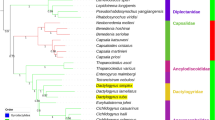Abstract.
The complete mitochondrial genomes of two microbats, the horseshoe bat Rhinolophus pumilus, and the Japanese pipistrelle Pipistrellus abramus, and that of an insectivore, the long-clawed shrew Sorex unguiculatus, were sequenced and analyzed phylogenetically by a maximum likelihood method in an effort to enhance our understanding of mammalian evolution. Our analysis suggested that (1) a sister relationship exists between moles and shrews, which form an eulipotyphlan clade; (2) chiropterans have a sister-relationship with eulipotyphlans; and (3) the Eulipotyphla/Chiroptera clade is closely related to fereuungulates (Cetartiodactyla, Perissodactyla and Carnivora). Divergence times on the mammalian tree were estimated from consideration of a relaxed molecular clock, the amino acid sequences of 12 concatenated mitochondrial proteins and multiple reference criteria. Moles and shrews were estimated to have diverged approximately 48 MyrBP, and bats and eulipotyphlans to have diverged 68 MyrBP. Recent phylogenetic controversy over the polyphyly of microbats, the monophyly of rodents, and the position of hedgehogs is also examined.
Similar content being viewed by others
Author information
Authors and Affiliations
Additional information
Received: 21 December 2000 / Accepted: 16 February 2001
Rights and permissions
About this article
Cite this article
Nikaido, M., Kawai, K., Cao, Y. et al. Maximum Likelihood Analysis of the Complete Mitochondrial Genomes of Eutherians and a Reevaluation of the Phylogeny of Bats and Insectivores. J Mol Evol 53, 508–516 (2001). https://doi.org/10.1007/s002390010241
Issue Date:
DOI: https://doi.org/10.1007/s002390010241




